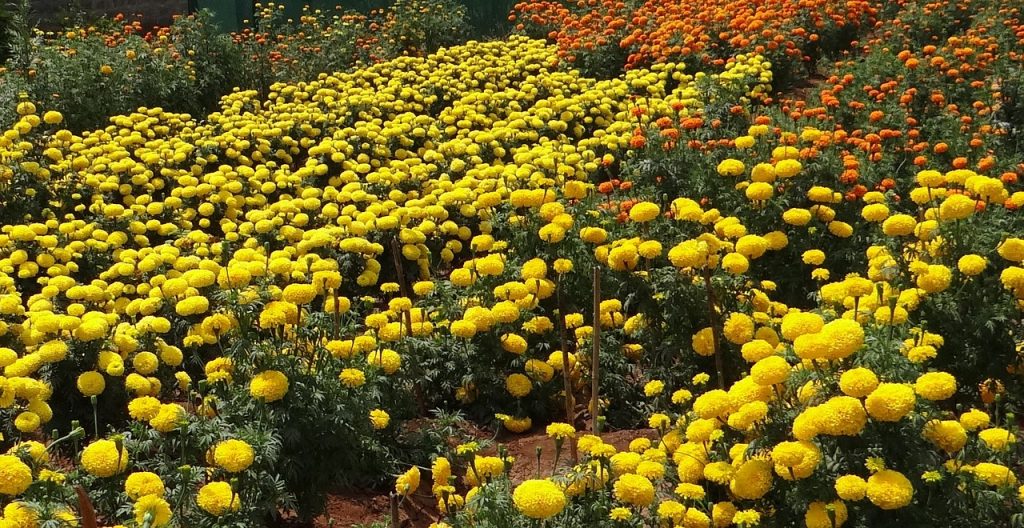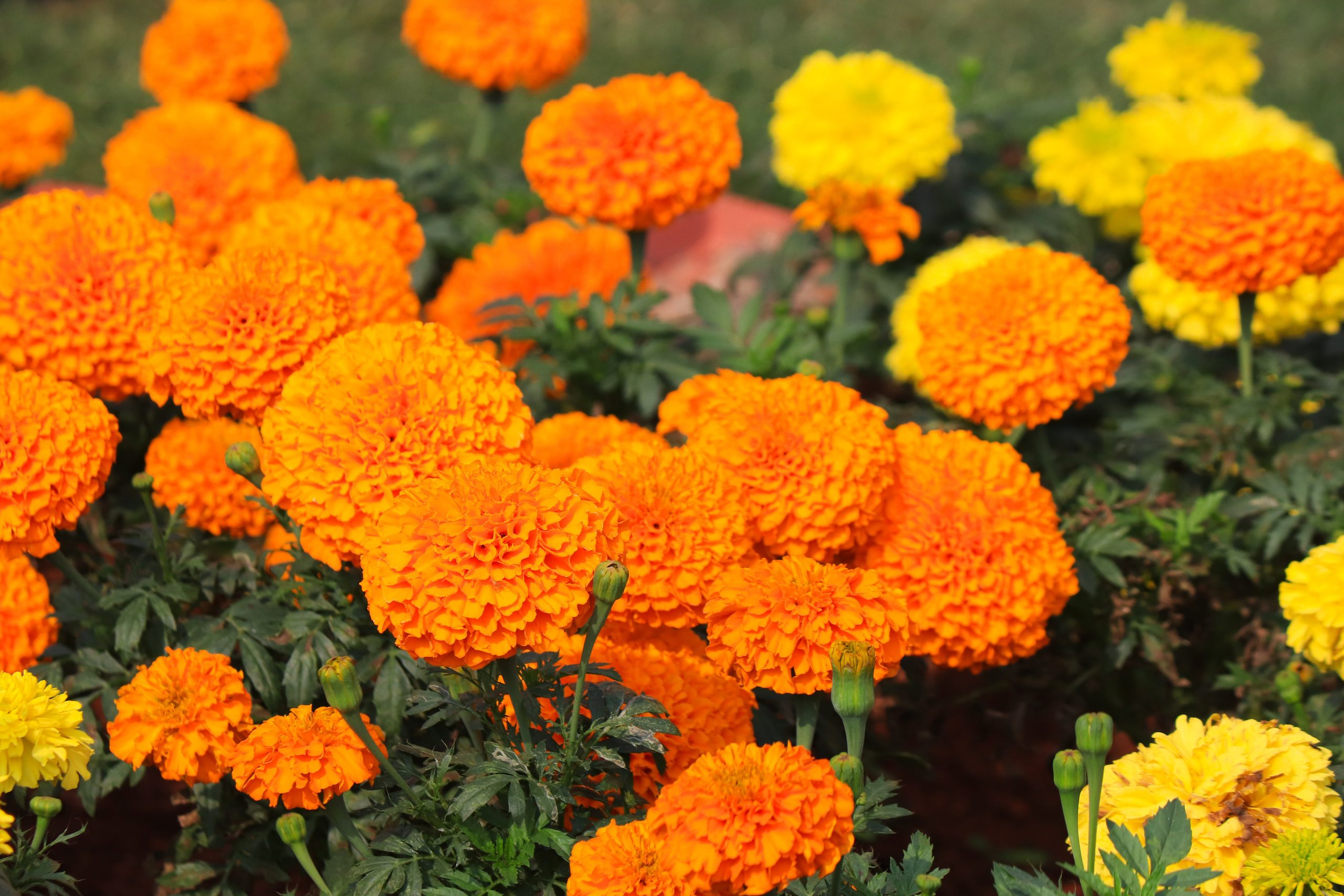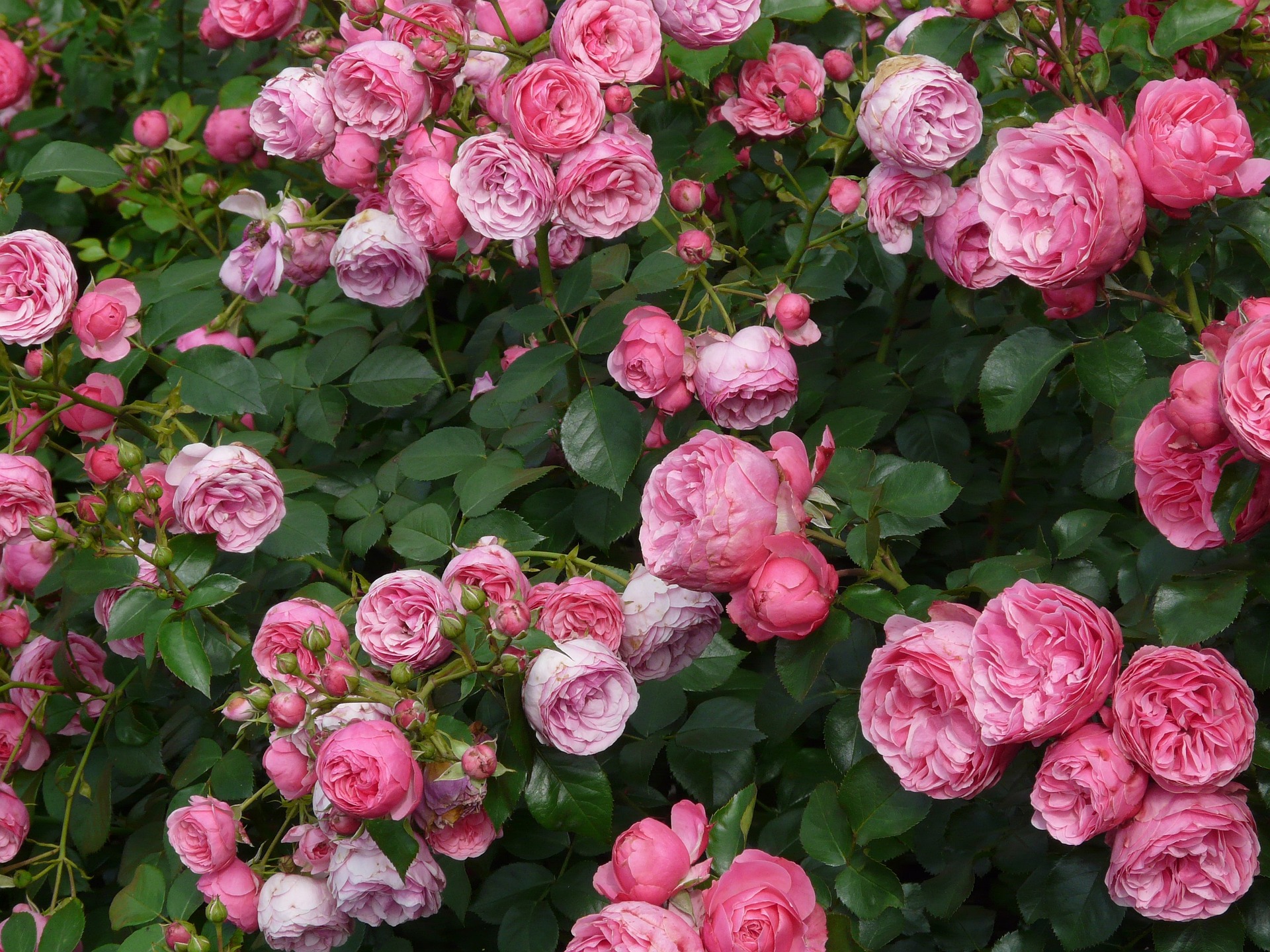Marigolds are known for their ease of cultivation. They are hardy plants that can thrive in various soil types and tolerate a wide range of growing conditions. This makes them suitable for both novice and experienced gardeners.
Their vibrant blooms that come in a wide range of colors brighten up summer gardens and provide a beautiful display in cut flower arrangements.
Here’s a guide on how to plant, grow, and care for marigolds:
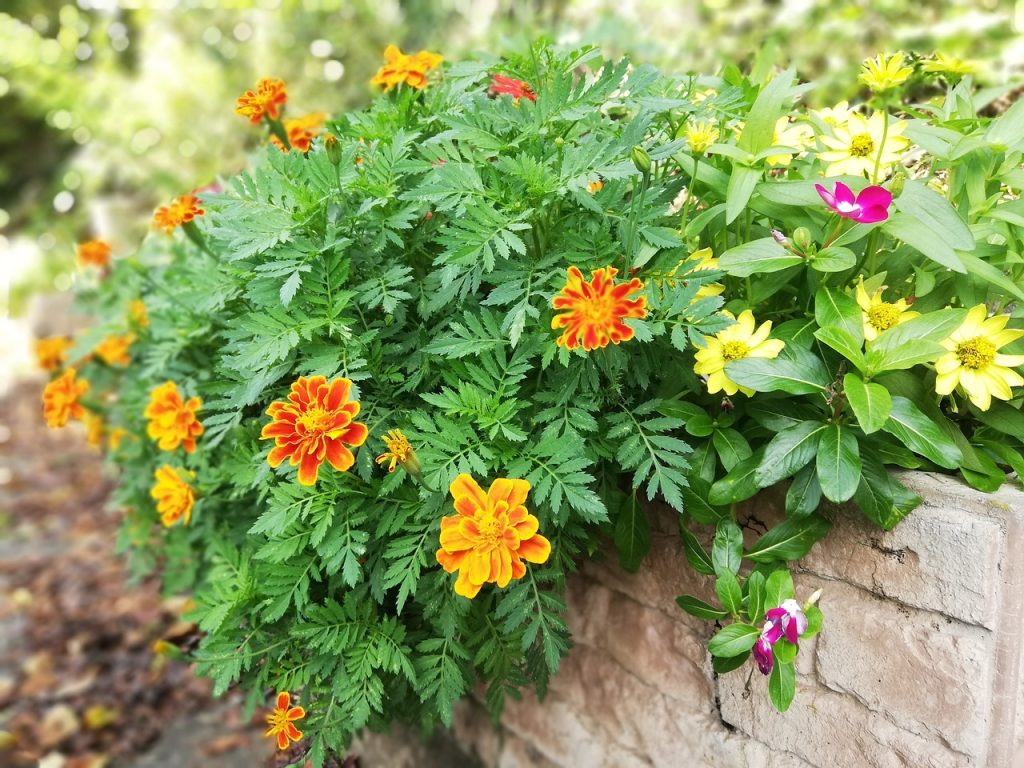
Description
Marigolds (Tagetes spp.) are annual flowers belonging to the family Asteraceae. They are grown for their vibrant blooms which display a range of colors including shades of orange, yellow, red, and maroon. Some varieties also have bi-color or multi-color blooms.
The foliage of marigolds is typically lacy or fern-like in appearance. The leaves are aromatic, and the scent is often described as musky or spicy. Marigolds are often used as companion plants to deter pests in vegetable gardens. Their strong scent helps repel nematodes and other harmful insects.
Marigolds can be planted in flower beds, borders and in containers.
| Botanical name: Tagetes spp. | Propagation: Seeds |
| Common name: Marigolds | Soil type: Well draining |
| Family: Asteraceae | Soil pH: 6.0-7.0 |
| Plant type: Annual | Temperature: 70-750F |
| Hardiness zones: USDA zones 2-11 | Light: Full sun |
| Mature size: 6-48in. tall, 6-28in. wide | Spacing: 6-18in. |
| Flower color: Orange, red, yellow, maroon, bicolor, multicolor | Pollination: Insects |
| Bloom time: Summer | Toxicity: Non toxic |
| Native area: Southern North America |
Temperature requirements
Marigolds are warm season annuals which grow best when temperatures are consistently between 70°F and 75°F (21°C to 24°C) during the day and not dropping below 50°F (10°C) at night.
They are sensitive to frost, so it’s essential to wait until all danger of frost has passed before planting them outdoors.
Marigolds generally tolerate high temperatures well. However, in extremely hot conditions, some varieties may benefit from partial shade or afternoon shade to prevent stress.
Soil requirements
Marigolds prefer well-drained soil. Avoid waterlogged conditions, as excessive moisture can lead to root rot.
Marigolds are adaptable to a wide range of soil pH levels, but they generally prefer slightly acidic to neutral soil with a pH between 6.0 and 7.0.
Marigolds are not particularly picky about soil fertility. They can grow in moderately fertile soil. Avoid excessive amounts of nitrogen, as this can result in lush foliage at the expense of flowers.
Light/Sun requirements
Grow marigolds in a location that receives full sunlight (at least 6-8 hours of sunlight per day). This will ensure optimum growth and flowering.
Types of Marigolds
Choose a variety based on your preferences and the intended use (e.g., bedding plants, containers, or borders).
When to plant Marigolds
Plant marigolds in late spring, when all danger of frost is gone. In warmer climates, marigolds can be planted during any time of the year.
Garden preparation
Remove any weeds, rocks, or debris from the planting area. Clearing the space ensures that the marigold plants have access to nutrients and reduces competition with unwanted plants.
Use a garden fork or tiller to loosen the soil to a depth of 6-8 inches (15-20 cm). This helps improve soil aeration, drainage, and root penetration. Break up any clumps and create a smooth, level surface.
Mix well-rotted compost or aged manure into the soil to enhance fertility. Organic matter also improves soil structure and provides a steady release of nutrients to the marigold plants.
Starting seeds indoors
Start seeds indoors, 6-8 weeks before the last frost date in your area.
Fill seed starting trays with seed starting mix and spread the seeds on the surface of the tray.
Cover the seeds with vermiculture and water the soil gently using a spray bottle or a watering can to ensure good seed to soil contact.
Place the trays in a location with bright indirect light or under grow lights.
About 1-2 weeks before the last expected frost, begin hardening off the seedlings by gradually exposing them to outdoor conditions. Transplant the marigold seedlings into the garden after all danger of frost has passed.
Direct Seeding
Marigolds can also be directly seeded outdoors after the last frost date. Plant the seeds about 1/8 inch deep in the soil.
Space marigold plants according to their mature size. Typically, space French marigolds 6-10 inches apart and African marigolds 10-18 inches apart.
How to Grow Marigolds in Containers
Use a high-quality, well-draining potting mix. Fill the containers, leaving about 1-2 inches (2.5-5 cm) from the rim to allow space for watering.
If using seeds, sow them according to the recommended spacing on the seed packet. If using young marigold plants, transplant them into the containers at the appropriate spacing.
Water the containers thoroughly after planting to settle the soil. Ensure that water drains freely from the bottom of the containers.
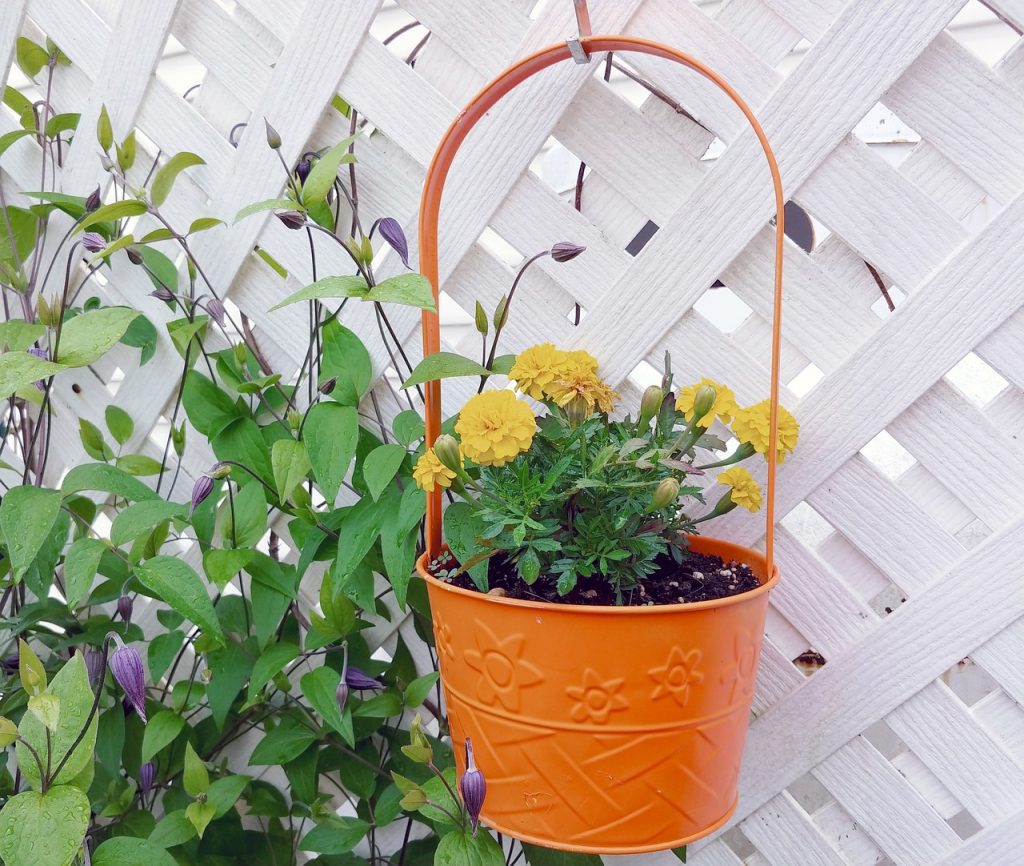
How to Care for Marigolds
Watering: Water marigolds regularly, especially during dry periods. Keep the soil consistently moist but not waterlogged. Once established, marigolds are somewhat drought-tolerant.
Deadheading: Remove spent flowers regularly to encourage continuous blooming. This also helps prevent the plant from going to seed too quickly.
Fertilization: Marigolds generally do well without much fertilizer. If your soil is poor, you can apply a balanced, all-purpose fertilizer at planting time.
Mulching: Applying a layer of mulch around marigold plants helps retain moisture, suppress weeds, and maintain a more consistent soil temperature.
Pinching: For bushier plants, pinch back the growing tips when the plants are young. This encourages branching and more flower production.
Pest Control: Marigolds are known for their ability to repel certain pests, including nematodes. However, they can be susceptible to spider mites and aphids. Monitor for pests and treat with insecticidal soap or neem oil.
Disease Prevention: Marigolds are generally resistant to many diseases. Ensure good air circulation by spacing plants properly to minimize the risk of fungal issues.
Harvesting Marigold flowers and seeds
Cut marigold flowers early in the morning when they are just starting to open up. Cut flowers from stems, which should be 12-18in. long. Place the freshly cut stems in a vase or container that has warm water. Marigolds have a vase life of one week.
If you want to harvest seeds for the next growing season, allow some flowers to mature and produce seeds. Harvest the dried seed heads, remove the seeds, and store them in a cool, dry place.

Additional Tips
Companion Planting: Plant marigolds near vegetables like tomatoes and beans to help deter certain pests.
Overwintering: Marigolds are annuals, but in warmer climates, they may reseed themselves, providing blooms in subsequent seasons.
